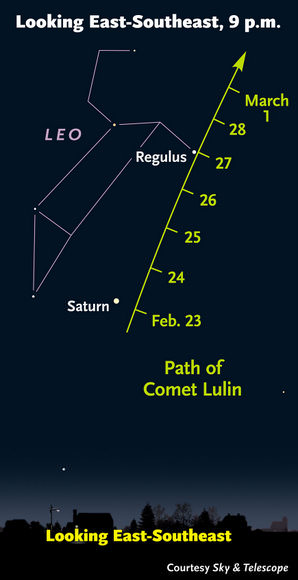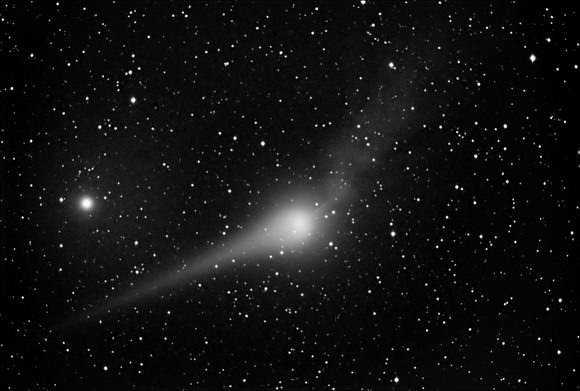[/caption]
We’ve received a few emails asking for more information about how to attempt to observe Comet Lulin. And Sky and Telescope has put out a great primer for seeing this green smudgeball in North America. Right now is the optimum time to try and see it. Sky and Telescope editor-in-chief Robert Naeye says Lulin should be at its best from Feb. 23 through the 28th. “In a very dark, unpolluted, natural night sky — such as few people see any more — the comet is dimly visible to the unaided eye,” writes Naeye. “Even in a more light-polluted suburban sky, however, a good pair of binoculars will do the trick. But you have to know exactly where to look.”
Start looking for Lulin after 9:00 pm (your local time) but the view will be better after 10:00 pm.
Here’s a star chart from SkyandTelescope.com/CometLulin.
And here’s the info from S&T:

“It shows the starry view high in the east-southeast in mid-evening. You should have no trouble spotting the planet Saturn and the star Regulus in the constellation Leo. They’re the two brightest things in the area.
“Using those as your guide, aim at the point on the comet’s path that’s labeled with the current date. The comet’s position is indicated for the evening hours on each date for the time zones of the Americas. The orientation of the scene with respect to the horizon is drawn for North America.
“You’re looking for a very dim, biggish, slightly oval cotton-puff floating among the tiny pinpoint stars. Look carefully, and you may detect the spike of the comet’s “anti-tail” pointing toward the lower left. The comet’s regular tail is actually dimmer, and it points in almost the opposite direction. In binoculars the whole thing looks more gray than greenish; to see color you need more light. In a large amateur telescope, the color and the comet’s structure are a lot more clearly visible.
“I saw it out my bathroom window with 10-by-50 binoculars,” says Alan MacRobert, a senior editor of Sky & Telescope. “It’s pretty plain if you get aimed at exactly the right spot.”
For more about Comet Lulin, its discovery, the reason for its two tails, check out Universe Today’s previous articles: one by Tammy about Lulin’s twisty tails, and one by Nancy, “Comet Lulin is on the Way!”.
Check out Spaceweather.com’s posting of pictures of Lulin from astronomers from all over the world.


@ fred houpt :
You are absolutely right.
One of the clues is that these comets give off x-rays.
X – rays are a result of Electromagnetic phenomenon.
Interplanetary space is full of electromagnetic processes and phenomenon.
Great call, Fred.
It’s worth pointing out that the anti-tail actually does not point towards the sun but an illusion given how the sun, earth and the comet are positioned.
A 2D photo does not give a good feel of how things are oriented in a 3D solar system.
http://www.daviddarling.info/encyclopedia/A/antitail.html
Tapping finger impatiently…..hmmm now, how long should I wait? Will anyone remember or know that these events are electric plasma events and not the sun heating up a snow ball event? Any takers? No?
what none of these are telling you is the SPEED at which lulin is moving. if you attempt to try to use one of these charts to pinpoint the location, you’re going to need to drive down the whole street to find it, ok? we’re talking about 8 degrees of sky in about 24 to 36 hours.
it zipped by saturn in a freekin’ flash!
start with your binos on saturn and focus the best you can… now begin moving slowly towards regulus. no matter what size or magnification factor on the binoculars you use, you’ll spot lulin as a bright, round “patch” that won’t be in focus and will appear to be about the size of a quarter on a dinner plate. once you’ve spotted it? THEN worry about refocusing the binos to see some tail structure. (it’s there… i’ve been watching it for weeks in 16X50s). the darker the sky site, the more “tail” you will see.
don’t expect it to be in the same place hours later… just start your sweep pattern once again. it’s fun to observe before you go to bed and get up early and look again before dawn. this baby has WINGS!
here’s a combination clip from one of our UT readers – Archer:
this isn’t a “live” shot, but rather a comination of many photos time lapsed over a short period. if you have patiece (and it’s warm enough where you live to tolerate an hour or so of steady observing) this is one of the few comets i’ve watched over the years that demonstrates its speed so well!
thanks for sharing, archer!
In light pollution areas like the Sacramento metro area, I see the best results with binoculars- first I locate it with a 10x50mm , then I use the 25x125mm binoculars my late uncle gave me as he bought the WW2 Naval Japanese binoculars for $25 in 1949, after
60 years and a lot of cleaning and care and now on a tripod, I can see some color and tail and looks great! The path to higher position above the horizon in the coming days will be nice, however, for me , this may be the last night to observe for a while as the rains returns tomorrow for the next few days
We reallly need the rains in California so I don’t mind if I miss some observation time.
Nancy, thank you for your feed article
I was able to easily spot it last night (2/24) with some checp 10X50’s that I carry in my car. From a site in Central Illinois that’s not exactly dark, it was right on the edge of naked eye visibility. In the binoculars, it was definitely elongated east-west and really cruising. I was able to discern a position shift after about 30 minutes.
I attempted to take some tripod photos with my little digital point & shoot, but its manual setting will only go as long as 15″, which wasn’t quite enough to capture it.
Man, I need a digital SLR…
My pleasure Tammy. I didn’t think you’d post it! It shows how bad my telescope doesn’t track when it’s cranky, which is often.
Also, thank you for the article Nancy!
Seeing/Transparency were both at 2/5 over here in Northeast Nebraska. It’s actually how I found it. I eye-balled how far it was from Saturn and towards Regulus on this site and others, and started taking pictures. In one shot, all the stars shifted (again, cranky telescope) except one that stood still. “There it is!”.
Each image is 60 sec exposure, taken 5 seconds apart.
Archer,
Awesome animation
Which star is to the lower left? It looks too dim to be Saturn. And given the speed at which it’s moving the images must be covering a small area and Saturn is way out of fov. Was this through a telescope or telephoto?
Hi ND,
Thank you. It’s not Saturn. Saturn is basically where I started, to get my focus somewhat close, then moved up Lulin’s path to Regulus. After some test photos of Saturn, I knew I was in trouble. It had some huge halos from the haziness.
The nearest star I can find from where I was at is Chi Leonis. I don’t think it shows in the animation.
This was through an 8″ Meade LX200acf, with a Canon 5D Mark II via a T-mount. No focal reducer, so F/10. From eye-balling it, I was probably 3 finger-widths from Saturn, to it’s northeast.
Tammy and Archer-
Thanks for the great additions!
Nancy
fred – “Will anyone remember or know that these events are electric plasma events and not the sun heating up a snow ball event?”
The comet is at 1.4 AU from the sun, at 1 Au from the sun we have about 100 degree celcius on the sun site, so at 1.4 AU this might be still 70 degrees celcius.
Even 10 degree celcius is way above freezing point so you are telling me that the sun has no effect?
I doubt this, I must do some more research into this…